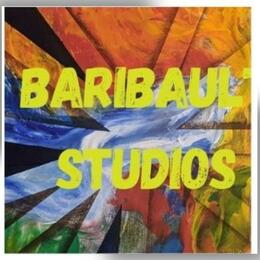About this Product
This acrylic painting depicts a beautifully stylized carousel horse, showcasing both dynamic energy and gentle elegance. Here's a detailed description:
Subject:
The painting focuses on a white carousel horse adorned with intricate harness decorations, including golden accents on its headgear and rein, which highlight its ornamental nature. A vibrant purple flower in the foreground adds a whimsical, lively touch to the composition.
Style:
The artist employs a blend of realistic elements (e.g., the horse's anatomy and detailed harness) and impressionistic brushwork, creating a dreamy and nostalgic atmosphere.
The horse appears in motion, evoking the joyful spirit of a carousel ride.
Color Palette:
The horse is predominantly white with soft gray and blue undertones, giving it a polished, ethereal look.
Warm gold and orange tones in the harness create contrast and draw the eye to the horse's face.
The background incorporates soft yellows and oranges, suggesting light and warmth, while the vibrant purple of the flower adds a playful, vibrant pop.
Brushwork and Technique:
The horse’s body features smooth, blended strokes that mimic the sheen of its surface, while the harness is painted with more defined lines to emphasize its intricate design.
The flower and other surrounding details appear looser and more textured, adding depth and variation to the piece.
Mood and Emotion:
The painting exudes a sense of nostalgia and whimsy, capturing the magic of childhood memories and the elegance of classic carousel horses. The color harmony and details make it both serene and vibrant.
Overall Composition:
The horse is the central figure, framed by soft background hues that enhance its prominence. The purple flower and subtle structural elements in the background balance the composition, guiding the viewer's eye across the canvas.
This painting beautifully conveys both the charm and timeless appeal of carousel horses, blending vibrant color and delicate craftsmanship.
Baribault studios
Meet the Maker
Jill Baribault is a celebrated artist and designer whose work transcends conventional boundaries, blending imagination with craftsmanship. As the creative force behind Baribault Studios, Jill has become known for her ability to transform ideas into stunning visual narratives. Her passion for art was ignited at an early age, drawing inspiration from the natural world, vibrant cultural motifs, and the timeless elegance of human emotion.
With a background in [insert relevant artistic or educational background, if known], Jill honed her skills across a variety of media, including [list key specialties, e.g., painting, sculpture, interior design, digital art, etc.]. Her works are marked by their meticulous attention to detail, innovative techniques, and an unerring commitment to storytelling through design.
Jill’s artistry has been showcased in [insert exhibitions, notable projects, collaborations, or features], earning her acclaim for her unique perspective and masterful execution. Beyond her studio, she is a passionate advocate for [mention philanthropic work, mentoring, or community involvement, if applicable], believing that art has the power to inspire, connect, and transform lives.
Today, Jill continues to push the boundaries of creativity, crafting pieces that resonate with depth, beauty, and originality, leaving a lasting imprint on the art and design landscape.
_jpg_363552128372_1732372938.jpeg?t=1732372938)
How it’s Made
1. Preparing the Canvas
The artist likely started with a primed canvas or a canvas board, ensuring a smooth surface for the acrylic paints.
2. Sketching the Composition
A light sketch of the carousel horse was probably done using pencil or charcoal to outline the horse's body, harness, and key elements like the flower and surrounding details.
Basic proportions and key features (e.g., the horse's face, the decorative harness, and the flower) were carefully mapped out to guide the painting process.
3. Base Layers
Background: A soft blend of warm yellows and oranges was applied as a base, using wide brushstrokes or a sponge to create a glowing, smooth backdrop.
Horse's Body: The artist would have laid down a base coat of white paint, then added blue and gray undertones to define the horse's form and give it dimension and shading.
4. Detailing the Horse
Highlights and Shadows: Layers of acrylic were built up using a combination of blending and glazing techniques. Lighter areas were accented with pure white paint, while shadows were achieved using muted blues and grays.
Harness and Decorative Elements: The harness and rein details were painted with bold orange and gold hues. These colors were carefully layered to create a smooth, polished look, giving the horse an ornate, carousel-like appearance.
5. Adding the Foreground Details
The purple flower was painted with loose yet deliberate brushstrokes, using vibrant purples and greens to make it stand out. This adds a whimsical touch to the composition.
The structure in the background, possibly part of the carousel pole or base, was added using muted colors to ensure it complements rather than overpowers the horse.
6. Final Touches
The artist likely used a fine-tipped brush to refine the horse’s features, including its eye, ear, and the small, precise lines on the harness.
Soft blending was used to smooth transitions between the horse’s body and the background.
Highlights were added to key areas (e.g., the horse’s face and harness) to give the painting a luminous, three-dimensional quality.
7. Varnishing
Once the painting was dry, a clear acrylic varnish may have been applied to protect the colors and enhance their vibrancy.
This method combines technical precision for the horse and decorative elements with looser, more expressive brushwork for the background and flower. It’s a wonderful example of blending realism with creativity!
_jpg_726045044398_1733017129_org.jpeg)





